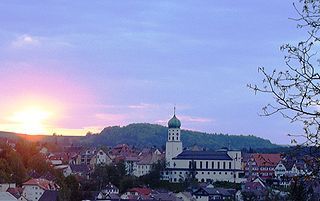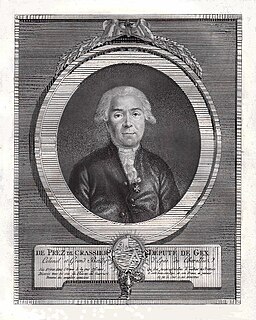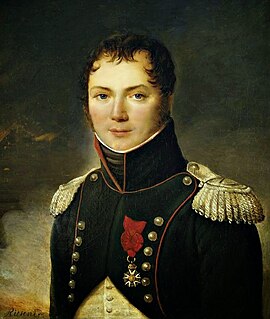Related Research Articles
The Army of the Moselle was a French Revolutionary Army from 1791 through 1795. It was first known as the Army of the Centre and it fought at Valmy. In October 1792 it was renamed and subsequently fought at Trier, First Arlon, Biesingen, Kaiserslautern, Froeschwiller and Second Wissembourg. In the spring of 1794 the left wing was detached and fought at Second Arlon, Lambusart and Fleurus before being absorbed by the Army of Sambre-et-Meuse. In late 1794, the army captured Trier and initiated the Siege of Luxembourg. During the siege, the army was discontinued and its divisions were assigned to other armies.

The Battle of Arlon saw a French Republican force under the command of Amable Henri Delaage face the Habsburgs's force led by Gottfried von Schröder. The French were victorious though they suffered higher casualties than the Austrians. The action was fought during the War of the First Coalition, part of the larger French Revolutionary Wars. Arlon is located in Belgium, a distance of 30 kilometres (19 mi) west of Luxembourg city.
In the Battle of Fleurus Jean-Baptiste Jourdan's French army repulsed an attack by the combined Austro-Dutch army led by Prince Josias of Saxe-Coburg-Saalfeld. Tactically the battle was a draw but strategically it was a decisive French victory. The battle led to the collapse of the Coalition position in the Austrian Netherlands.

On 25 March 1799, French and Habsburg armies fought for control of the geographically strategic Hegau in present-day Baden-Württemberg. The battle has been called by various names: First Battle of Stockach, the Battle by Stockach, and, in French chronicles, the Battle of Liptingen.

In the Battle of Hohenlinden on 3 December 1800, a French army commanded by Jean Victor Marie Moreau decisively defeated the army of Habsburg Monarchy led by Archduke John. The first action of the campaign was the Battle of Ampfing, two days earlier. After Hohenlinden there was a series of rearguard clashes beginning on 9 December at Rosenheim and continuing from the 14th through the 20th at Salzburg, Neumarkt am Wallersee, Frankenmarkt, Schwanenstadt, Vöcklabruck, Lambach, and Kremsmünster. During the retreat, the Habsburg army began a process of disintegration and an armistice was concluded a few days later.

The Battle of Ettlingen or Battle of Malsch was fought during the French Revolutionary Wars between the armies of the First French Republic and Habsburg Austria near the town of Malsch, 9 kilometres (6 mi) southwest of Ettlingen. The Austrians under Archduke Charles, Duke of Teschen tried to halt the northward advance of Jean Victor Marie Moreau's French Army of Rhin-et-Moselle along the east bank of the Rhine River. After a tough fight, the Austrian commander found that his left flank was turned. He conceded victory to the French and retreated east toward Stuttgart. Ettlingen is located 10 kilometres (6 mi) south of Karlsruhe.

Caldiero 1805 order of battle

Louis-Michel-Antoine, comte Sahuc, was a French army general born 7 January 1755 – died 24 October 1813, joined the French Royal Army and spent 20 years there before fighting in the French Revolutionary Wars. He rose to command a French cavalry regiment and later became a general officer. During the Napoleonic Wars he held important cavalry commands in three of Emperor Napoleon I of France's wars.
The Piave River 1809 order of battle shows the units and organization for the Franco-Italian and Austrian Empire armies that fought in the Battle of Piave River on 8 May 1809. Eugène de Beauharnais, the viceroy of the Kingdom of Italy defeated Archduke John of Austria. Eugène's Advance Guard crossed the river first and was assailed by Austrian cavalry and artillery. The French cavalry routed the opposing cavalry and captured 14 enemy guns. A lull followed as John arranged his infantry in a formidable defensive position. Meanwhile, Eugène struggled to pour reinforcements into the bridgehead as the Piave rose dangerously. In the afternoon, the viceroy sent Paul Grenier to drive back the Austrian left while Jacques MacDonald mounted an assault on the center. The attack succeeded in breaking the Austrian line and compelling John to order a retreat.
Jean-Baptiste Meynier, born 22 April 1749 – died 3 December 1813, was a French soldier who served during the American Revolutionary War, the French Revolutionary Wars, and the Napoleonic Wars. Between 1792 and 1793, he rose from a captain to a general of division. During the Montenotte Campaign in 1796, he commanded a division under Napoleon Bonaparte, who had a low opinion of his military talent. In 1803 he was appointed to command the fortress of Mainz. He died there in 1813.
At the Battle of Höchst, the Habsburg Austrian army commanded by François Sébastien Charles Joseph de Croix, Count of Clerfayt outmaneuvered the French Republican Army of Sambre-et-Meuse commanded by Jean-Baptiste Jourdan. Although the French attacked first, they were unable to dislodge an Austrian flanking column. Afterward Jourdan's army retreated to the north. The clash happened during the War of the First Coalition, part of a wider conflict known as the French Revolutionary Wars. Modern-day Höchst is a suburb and administrative district of Frankfurt am Main in the state of Hesse in Germany. Höchst is about 12 kilometers (7 mi) west of the Frankfurt city center.
The Battle of Pirmasens saw a French Republican corps led by Jean René Moreaux attack a Kingdom of Prussia force led by Charles William Ferdinand, Duke of Brunswick-Wolfenbüttel. From prepared positions, the Prussians caught the French in a deadly crossfire, forcing them to withdraw. The clash happened during the War of the First Coalition, part of a larger conflict known as the French Revolutionary Wars. In 1793 Pirmasens was part of the Landgraviate of Hesse-Darmstadt but today the city is in the state of Rhineland-Palatinate in Germany, 34.4 kilometres (21 mi) south of Kaiserslautern.

The Battle of Gosselies or Battle of Charleroi saw a Republican French army co-commanded by Jacques Desjardin and Louis Charbonnier try to cross the Sambre River against a joint Dutch and Habsburg Austrian army under William, Hereditary Prince of Orange. The French defeat in the battle marked the third of five attempts by their armies to win a foothold on the north bank of the Sambre during the War of the First Coalition. In 1794, Gosselies was a separate village but is now part of the Charleroi municipality, about 7 kilometres (4 mi) north of the city center. Charleroi is located about 60 kilometres (37 mi) south of Brussels.
Jacques Philippe Bonnaud or Bonneau commanded a French combat division in a number of actions during the French Revolutionary Wars. He enlisted in the French Royal Army as cavalryman in 1776 and was a non-commissioned officer in 1789. He became a captain in the 12th Chasseurs à Cheval Regiment in 1792. The unit fought at Valmy, Jemappes, Aldenhoven, Neerwinden, Raismes, Caesar's Camp and Wattignies, and he was wounded twice. In January 1794 he was promoted to general officer. In April 1794, he reluctantly accepted command of a division that had been cut to pieces at Villers-en-Cauchies and Troisvilles, and this at a time when failed generals often were sent to the guillotine. He led his troops at Courtrai, Tourcoing and in the invasion of the Dutch Republic. He fought in the War in the Vendée the following year, briefly leading the Army of the Coasts of Cherbourg. In the Rhine Campaign of 1796 he led a cavalry division in combat at Amberg, Würzburg and Limburg. He was badly wounded in the latter action and never recovered, dying at Bonn six months later. BONNEAU is one of the names inscribed under the Arc de Triomphe, on Column 6.
Jean-Marie Forest, 4 February 1752 Lyon – 12 June 1794 Modena was a general of the French Revolution.

Jean Hardy commanded a French division during the French Revolutionary Wars. In 1783 he enlisted in the French Royal Army. In 1792 he joined a volunteer battalion and fought at Valmy, earning promotion to major. After leading a battalion at Wattignies and successfully holding Philippeville in 1793, he became a general of brigade. In 1794, he led troops in the Army of the Ardennes at Boussu-lez-Walcourt, Grandreng, Gosselies and Fleurus.
Paul-Alexis Dubois commanded French divisions during the War of the First Coalition and was killed in action fighting against Habsburg Austria. He enlisted in a French infantry regiment in 1770 and transferred into the cavalry in 1776. Thereafter he served in several different cavalry and infantry regiments. From sous-lieutenant in 1791, he served in the Army of the Moselle and was rapidly promoted to general of brigade by August 1793. After briefly commanding an infantry division in the Army of the Rhine at Wissembourg he switched back to the Army of the Moselle to fight at Kaiserslautern before being wounded at Froeschwiller in December 1793.

Jean Étienne Philibert de Prez de Crassier or Étienne Desprez-Crassier was a French political and military leader in the early years of the French Revolutionary Wars. Despite being from the minor nobility, he entered the French Royal Army as a cadet at the age of 12 because of his family's poverty. He fought in the War of the Austrian Succession and the Seven Years' War, becoming a colonel in 1785 and retiring two years later. Voltaire lent him the money needed to recover the Deprez family property. He was elected to the Estates General as a nobleman in 1789. After being promoted to lieutenant general he led a division at Valmy in 1792. He became commander of the Army of the Rhine and Army of the Western Pyrenees. Imprisoned during the Reign of Terror, he was released and restored to his former rank but retired in 1796.

Charles Claude Jacquinot commanded a French cavalry division at the Battle of Waterloo in 1815. He joined a volunteer battalion in 1791 and transferred to a light cavalry regiment as a junior officer in 1793. He earned promotion to squadron commander and was acting commander of his regiment at Hohenlinden in 1800. After serving in a staff position at Austerlitz in 1805, he led a light cavalry regiment at Jena in 1806. Promoted to general of brigade he led his horsemen at Abensberg, Raab and Wagram in 1809. During the French invasion of Russia he fought at Ostrovno, Smolensk and Borodino in 1812. During the 1813 German Campaign he led a cavalry brigade at Dennewitz and Leipzig. After being appointed general of division he fought at Second Bar-sur-Aube and Saint-Dizier in 1814. During the Hundred Days he rallied to Napoleon and led a light cavalry division in the Waterloo campaign. After 15 years of inactivity, he was restored to favor in the 1830s. Thereafter he held a number of commands and was appointed to the Chamber of Peers. His surname is one of the names inscribed under the Arc de Triomphe, on Column 20.
The Battle of Maudach occurred on 15 June 1796 between the French Revolutionary Army and the Army of the First Coalition. This was the opening action of the Rhine Campaign of 1796 on the Upper Rhine, slightly north of the town of Kehl. The Coalition, commanded by Franz Petrasch, lost 10 percent of its manpower missing, killed or wounded. It was fought at the village of Maudach, southwest of Ludwigshafen on the Rhine river opposite Mannheim. Maudach lies 10 km (6 mi) northwest of Speyer and today is a southwest suburb of Ludwigshafen; a principal town on the Rhine river in 1796.
References
- ↑ (in French) Paul Gayant, Tableu des guerres de la Révolution, de 1792 à 1815. Paulin, 1838, pp. 100–106.